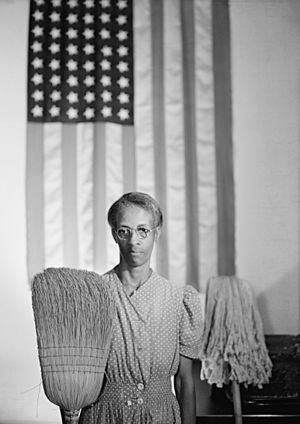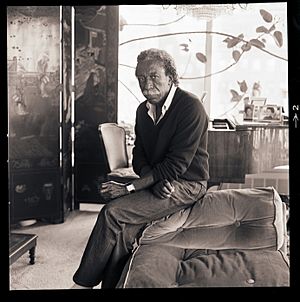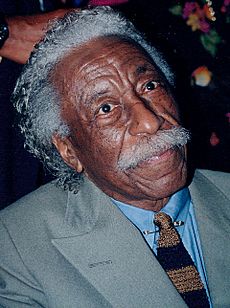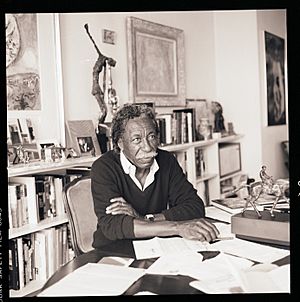Gordon Parks facts for kids
Quick facts for kids
Gordon Parks
|
|
|---|---|
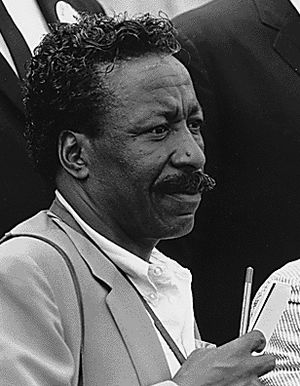
Parks at the Civil Rights March on Washington, 1963
|
|
| Born |
Gordon Roger Alexander Buchanan Parks
November 30, 1912 Fort Scott, Kansas, U.S.
|
| Died | March 7, 2006 (aged 93) Manhattan, New York City, U.S.
|
|
Works
|
Life photographic essays Shaft The Learning Tree Solomon Northup's Odyssey A Choice of Weapons (memoir) |
| Children | Gordon Parks, Jr. David Parks Leslie Campbell Parks Toni Parks-Parsons |
| Awards | NAACP Image Award (2003) PGA Oscar Micheaux Award (1993) National Medal of Arts (1988) Spingarn Medal (1972) |
Gordon Roger Alexander Buchanan Parks (born November 30, 1912 – died March 7, 2006) was an amazing American artist. He was a photographer, a composer, an author, a poet, and a film director.
Gordon Parks became famous for his documentary photojournalism from the 1940s to the 1970s. He focused on important topics like civil rights, poverty, and the lives of African Americans. He also did beautiful glamour photography.
People remember him most for his powerful photos of poor Americans in the 1940s. These were taken for a special government project. He also created many photo essays for Life magazine. As a director, he made the popular film Shaft and the movie The Learning Tree, which was based on his own life.
Parks was one of the first black American filmmakers to direct movies in Hollywood. He made films about the experiences of enslaved people and black Americans facing challenges. His film Shaft helped create a new type of movie called "blaxploitation." The National Film Registry called The Learning Tree the first feature film by a black director to be funded by a major Hollywood studio.
Contents
Growing Up
Gordon Parks was born in Fort Scott, Kansas, on November 30, 1912. His parents were Andrew Jackson Parks and Sarah Ross. He was the youngest of 15 children. His father was a farmer who grew many different vegetables and raised animals like ducks and chickens.
Gordon went to an elementary school where black and white students were kept separate. His high school had both black and white students because the town was small. However, black students were not allowed to play sports or go to school social events. They were also told not to dream about going to college. Parks remembered a teacher telling him that college would be a waste of money for him.
When Gordon was 11, three white boys threw him into the Marmaton River, thinking he could not swim. He was quick-thinking and ducked underwater so they would not see him swim to safety. His mother passed away when he was 14. He spent his last night at home sleeping next to her coffin. This helped him find comfort and face his fear of death.
Soon after, he moved to St. Paul, Minnesota, to live with his sister and her husband. He and his brother-in-law often argued. At 15, Gordon was left on the street to take care of himself. To survive, he worked many jobs. He was a singer, a piano player, a busboy, a traveling waiter, and a semi-pro basketball player. In 1929, he worked briefly at an exclusive club called the Minnesota Club. There, he read many books from the club's library. When the Wall Street Crash of 1929 caused the club to close, he rode a train to Chicago. He found a job at a cheap hotel there.
Gordon Parks' Amazing Career
Becoming a Photographer
At 28 years old, Gordon Parks saw powerful photos of migrant workers in a magazine. He was so inspired that he bought his first camera, a Voigtländer Brillant, for $12.50 at a pawnshop in Seattle, Washington. He taught himself how to take pictures. The people who developed his first roll of film were very impressed. They encouraged him to try fashion photography at a women's clothing store in St. Paul, Minnesota.
These fashion photos caught the attention of Marva Louis, the wife of boxing champion Joe Louis. She encouraged Gordon and his wife, Sally Alvis, to move to Chicago in 1940. There, he started a business taking portraits, especially of society women. His photography in Chicago, showing the lives of African Americans, earned him the Julius Rosenwald Fellowship in 1942. This fellowship paid him $200 a month and let him choose where to work. This led him to join the Farm Security Administration (FSA). The FSA was documenting the country's social conditions.
Working for the Government
Over the next few years, Parks moved between jobs. He also worked as a freelance portrait and fashion photographer. He started taking pictures of the black community in Chicago's South Side. In 1941, an exhibition of these photos won him a photography fellowship with the FSA.
While working as a trainee at the FSA, Parks created one of his most famous photos, American Gothic, Washington, D.C. This photo was named after the famous painting American Gothic. That painting shows a traditional white farmer and his daughter. Parks's photo showed a black woman named Ella Watson. She worked on the cleaning crew of the FSA building. She stood stiffly in front of an American flag, holding a broom. Parks was inspired to take this picture after experiencing racism in restaurants and shops in the segregated capital city.
When his boss, Roy Stryker, saw the photo, he said it was a strong statement about America. He worried it could get all his photographers fired. But he told Parks to keep working with Ella Watson. This led to a series of photos showing her daily life. Parks later said his first image was too obvious. However, others believe its strong message made it very impactful.
Parks's work for the government, where he used his camera "as a weapon," gained much attention. After the FSA closed, Parks stayed in Washington, D.C. He worked as a correspondent for the Office of War Information. There, he photographed the all-black 332d Fighter Group, known as the Tuskegee Airmen. He could not follow them overseas, so he left the O.W.I. He later joined the Standard Oil Photography Project in New Jersey. This project sent photographers to take pictures of small towns and factories. Some of his notable photos from this time include Dinner Time at Mr. Hercules Brown's Home, Somerville, Maine (1944) and Grease Plant Worker, Pittsburgh, Pennsylvania (1946).
Commercial and Civic Photography
Parks then looked for more fashion photography jobs. After leaving the Office of War Information, he moved to Harlem. He became a freelance fashion photographer for Vogue magazine. Despite the racist attitudes of the time, Vogue editor Alexander Liberman hired him to photograph evening gowns. Over the next few years, Parks developed a unique style. He photographed his models in motion instead of in still poses. During this time, he published his first two books: Flash Photography (1947) and Camera Portraits (1948).
In 1948, a photo essay he did about a young Harlem gang leader won Parks a job at Life magazine. He worked as a photographer and writer for Life until 1972. For over 20 years, Parks took photos on many subjects. These included fashion, sports, Broadway shows, poverty, and racial segregation. He also took portraits of famous people like Malcolm X, Muhammad Ali, and Barbra Streisand. He became one of the most celebrated photojournalists in the United States.
His 1956 photo essay for Life magazine, called "The Restraints: Open and Hidden," showed the effects of racial segregation. It followed the daily lives of three families in and near Mobile, Alabama. Experts note that Parks documented the Jim Crow South very well. But he did not just focus on protests or violence. Instead, he showed the everyday details of these families' lives.
In 2015, an exhibition of photos from a 1950 project for Life was shown at the Boston Museum of Fine Arts. Parks had returned to his hometown, Fort Scott, Kansas, where segregation still existed. He documented the conditions there and the lives of his 11 classmates from his segregated middle school. Life magazine never published this work.
During his years with Life, Parks also wrote books about photography. In 1960, the American Society of Magazine Photographers named him Photographer of the Year. His fashion photography continued to appear in Vogue from the mid-1940s to the late 1970s.
Directing Films
In the 1950s, Parks worked as a helper on different Hollywood movies. Later, he directed documentaries about life in black neighborhoods. These were made for National Educational Television. In 1969, he directed his first feature film, The Learning Tree, for Warner Bros.-Seven Arts. This movie was based on his own book and filmed in his hometown of Fort Scott, Kansas. Parks also wrote the script and composed the music for the film.
Shaft, a detective film from 1971, was directed by Parks. It starred Richard Roundtree as John Shaft and became a huge success. Parks's skill with settings was clear in Shaft. The movie showed a cool, leather-clad black private detective hired to find a kidnapped girl.
Parks also directed the 1972 sequel, Shaft's Big Score. In this movie, the main character gets caught between rival gangs. Parks also directed The Super Cops (1974) and Leadbelly (1976). Leadbelly was a movie about the blues musician Huddie Ledbetter. In the 1980s, he made several films for television. He also composed music and wrote a story for Martin, a ballet honoring Martin Luther King Jr.. This ballet first showed in Washington, D.C., in 1989. It was shown on national television on King's birthday in 1990.
In 2000, Gordon Parks had a small role in the Shaft sequel. This movie starred Samuel L. Jackson as the nephew of the original John Shaft. In his scene, Parks was playing chess when Jackson greeted him as "Mr. P."
Musician and Composer
Gordon Parks's first job as a teenager was playing the piano. He also performed as a jazz pianist. His song "No Love" was played on a national radio show by Larry Funk and his orchestra in the early 1930s.
Parks composed Concerto for Piano and Orchestra (1953). He was encouraged by black American conductor Dean Dixon and his wife Vivian, a pianist. He also had help from composer Henry Brant. He finished Tree Symphony in 1967. In 1989, he composed and directed Martin, a ballet dedicated to Martin Luther King Jr.
Writing Books
In the late 1940s, Parks started writing books about photography. This second career led to 15 books and his role as a famous black filmmaker. His book The Learning Tree, which was partly about his own life, was published in 1963. He wrote several poetry books, which he illustrated with his own photos. He also wrote three books about his life: A Choice of Weapons (1966), Voices in the Mirror (1990), and A Hungry Heart (2005).
In 1981, Parks wrote a novel called Shannon. It was about Irish immigrants trying to improve their lives in New York in the early 1900s. Parks's writing includes novels, poetry, autobiographies, and non-fiction. He wrote both photography guides and books about making films.
Painting Art
Parks also created abstract oil paintings related to his photography. These were shown in a 1981 exhibition in New York. The show was called "Gordon Parks: Expansions: The Aesthetic Blend of Painting and Photography."
Essence Magazine
In 1970, Gordon Parks helped start Essence magazine. He was its editorial director for the first three years.
Personal Life
Gordon Parks was married three times. His first two wives were Black. He married Sally Alvis in Minneapolis in 1933. They divorced in 1961 after more than 25 years. In 1962, he married Elizabeth Campbell. They divorced in 1973. Parks met Chinese-American editor Genevieve Young in 1962 when he started writing The Learning Tree. She was assigned to be his editor. They became close and married in 1973. This was his shortest marriage, lasting six years, and they divorced in 1979.
Parks had four children with his first two wives: Gordon, Jr., David, Leslie, and Toni. His oldest son, Gordon Parks, Jr., who also had many talents like his father, died in a plane crash in 1979 in Kenya. He had gone there to direct a film. David, another son, is an author. His first book, GI Diary, was published in 1968.
Parks lived for a long time in Greenburgh, New York. His house there became a landmark in 2007.
Parks had five grandchildren: Alain, Gordon III, Sarah, Campbell, and Satchel. Malcolm X honored Parks by asking him to be the godfather of his daughter, Qubilah Shabazz.
Legacy and Impact
In Film
Gordon Parks's 1971 film Shaft helped create the "blaxploitation" film genre. This type of action film became popular in the United States in the early 1970s. Shaft also changed how Hollywood viewed African Americans. It introduced the black action hero into mainstream movies.
Director Spike Lee says Parks is an inspiration. He noted that Parks made his films when there were no black directors, which is inspiring enough.
The Sesame Street character Gordon was named after Gordon Parks.
In Music
- One of Parks's photographs, 1956 Alabama, is used for the album cover of Common's Like Water for Chocolate. It shows a young black woman in Alabama, dressed for church, drinking from a "colored only" drinking fountain.
- Parks is mentioned in Kendrick Lamar's music video for his song "ELEMENT.". In the video, some of Parks's famous photographs come to life.
Preserving His Work
Many places keep and share Gordon Parks's work.
The Gordon Parks Foundation The Gordon Parks Foundation in Pleasantville, New York, works to keep Gordon Parks's art safe forever. They make it available to the public through exhibitions, books, and online. The foundation also supports art and education that helps achieve what Gordon called "the common search for a better life and a better world." This includes scholarships for art students and help for researchers. Their building has a free exhibition space with changing photo displays. The foundation works with other groups to achieve its goals.
The Gordon Parks Museum/Center The Gordon Parks Museum/Center in Fort Scott, Kansas, has many of Parks's photos and personal items. He gave some to the museum and left others to it after he passed away. The collection includes his awards, medals, personal photos, paintings, drawings, and his collection of Life magazines. The museum also has some of Parks's cameras and his writing desk.
Library of Congress, Washington, D.C. The Library of Congress (LOC) in Washington, D.C., received Parks's personal collection in 1995. This included his papers, music, photos, films, and drawings. The LOC already had his early photojournalism projects. These were photos he took for the Farm Security Administration (1942–43) and the Office of War Information (1943–45).
In April 2000, the LOC honored Parks as a "Living Legend." He was one of only 26 writers and artists to receive this honor. The LOC also keeps Parks's published and unpublished music, and several of his films and TV shows.
National Film Registry Gordon Parks's film about his own life, The Learning Tree, and his action-drama Shaft, are both kept safe forever in the National Film Registry of the Library of Congress. The Learning Tree was one of the first 25 films chosen for the National Film Registry.
National Archives, Washington, D.C. The National Archives has the film My Father, Gordon Parks (1969). This film is about Parks and how he made The Learning Tree. They also have a copy of Solomon Northup's Odyssey. This film was made by Parks for Public Broadcasting System and was about a man's experience as an enslaved person. The Archives also hold many photos from Parks's time working for the government.
Smithsonian Institution, Washington, D.C. The Smithsonian Institution has a large collection of items related to Parks, especially his photographs.
Wichita State University In 1991, Wichita State University (WSU) in Wichita, gave Parks its highest honor, the President's Medal. However, in the mid-1990s, WSU returned a collection of 150 of his famous photos. This upset Parks. City officials in Wichita also did not want to acquire many of his papers and photos.
By 2000, WSU and Parks had resolved their differences. The university started honoring Parks again and collecting his work. In 2008, the Gordon Parks Foundation chose WSU to store 140 boxes of his photos, writings, and letters. In 2014, WSU acquired another 125 of his photos from the foundation. These are displayed at the university's Ulrich Museum of Art.
Kansas State University The Gordon Parks Collection at Kansas State University mainly shows how his film The Learning Tree was made. The Marianna Kistler Beach Museum of Art at Kansas State University has 204 Gordon Parks photographs. This collection includes 128 photos that Parks chose and gave to K-State in 1973. He did this after receiving an honorary degree from the university in 1970. The gift included black and white photos from 1949 to 1970 and color photos from his private collection. This was the first time Parks specifically selected photos for a public institution. The collection also has 73 photos taken after Parks visited Manhattan, Kansas, in 1984 and 1985. These photos show places in and around Manhattan, including churches, historic homes, and K-State buildings and students.
Exhibitions of His Work
- 1984: The Photographs of Gordon Parks, Minnesota Museum of American Art, St. Paul, MN
- 1997: Half past autumn : a retrospective Gordon Parks, Corcoran Gallery of Art, Washington, D.C. (A look back at his whole career.)
- 2013: Gordon Parks: The Making of an Argument, New Orleans Museum of Art.
- 2015: Gordon Parks: Back to Fort Scott, Boston Museum of Fine Arts.
- 2015: Gordon Parks: Segregation Story, High Museum of Art, Atlanta.
- 2016: Invisible Man: Gordon Parks and Ralph Ellison in Harlem, Art Institute of Chicago, Chicago, IL.
- 2017: Gordon Parks: camera is my weapon, Zachęta Gallery, Warsaw, Poland.
- 2018: Gordon Parks: The Flavio Story, Ryerson Image Centre, Toronto, Ontario and the Getty Museum, Los Angeles.
- 2019: Gordon Parks: The New Tide, Early Work 1940-1950, Amon Carter Museum of American Art, Fort Worth, Texas.
- 2020: Gordon Parks X Muhammad Ali, The Image of a Champion, 1966/1970, Nelson-Atkins Museum of Art, Kansas City, Missouri. (Photos from two Life magazine assignments.)
- 2020: A Choice of Weapons Honor and Dignity: The Visions of Gordon Parks and Jamel Shabazz, Minnesota Museum of American Art, St. Paul, MN.
- 2021: "The Impact of Gordon Parks," multiple Parks films screened and a discussion panel, Tallgrass Film Festival, Wichita, Kansas.
Collections of His Work
Work by Parks is held in these public collections:
- Art Institute of Chicago, Chicago, IL
- Minneapolis Institute of Art, Minneapolis, MN
- Cleveland Museum of Art
- Minnesota Museum of American Art, St. Paul, MN
- Nelson-Atkins Museum of Art, Kansas City, MO
Awards and Honors
- Parks received over 20 honorary doctorates during his lifetime.
- 1941: Awarded a fellowship for photography from the Rosenwald Fund. This allowed him to work with the Farm Security Administration.
- 1961: Named "Magazine Photographer of the Year" (1960) by the American Society of Magazine Photographers.
- 1970: Kansas State University gave Parks an honorary Doctor of Letters degree.
- 1972: The NAACP awarded Parks the Spingarn Medal.
- 1974: Kansas State University held a week-long "Gordon Parks Festival" from November 4–11.
- 1976: Received an honorary Doctor of Humanities degree from Thiel College.
- 1989: The United States Library of Congress chose The Learning Tree as one of the first 25 films to be kept forever in the National Film Registry. This was because it was "culturally, historically, or aesthetically significant." It was also the first film directed by an African American to be funded by a major Hollywood studio.
- 1990: Received the Missouri Honor Medal for Distinguished Service in Journalism from the Missouri School of Journalism.
- 1998: Won the Anisfield-Wolf Book Award for Lifetime Achievement.
- 1999: Gordon Parks Elementary School, a public charter school in Kansas City, Missouri, was started to educate children in the city.
- 2000: Received the Congress of Racial Equality Lifetime Achievement Award.
- 2000: The Library of Congress chose Parks's film Shaft for National Film Registry preservation.
- 2000 (April): The Library of Congress honored Parks as a "Living Legend." This award recognizes artists, writers, and others who have made important contributions to America's culture.
- 2001: Received the Kitty Carlisle Hart Award from the Arts & Business Council of New York.
- 2002: Received the Jackie Robinson Foundation Lifetime Achievement Award.
- 2002: Was added to the International Photography Hall of Fame and Museum.
- 2004: The Art Institute of Boston awarded him an honorary degree of Doctor of Humane Letters.
- 2008: An alternative learning center in Saint Paul, Minnesota, was renamed Gordon Parks High School after getting a new building.
- 2021: The Gordon Parks Award for Black Excellence in Filmmaking was started in his honor at the Tallgrass Film Festival.
Works by Gordon Parks
Books
- Flash Photography (1947)
- Camera Portraits: Techniques and Principles of Documentary Portraiture (1948) (about documentary photography)
- The Learning Tree (1964) (partly about his own life)
- A Choice of Weapons (1967) (about his life)
- Born Black (1970) (a collection of essays and photos)
- Flavio (1978)
- To Smile in Autumn (1979) (about his life)
- Voices in the Mirror, New York: Doubleday (1990) (about his life)
- The Sun Stalker (2003) (a biography about J. M. W. Turner)
- A Hungry Heart (2005) (about his life)
- Gordon Parks: Collected Works (2012)
- The New Tide: Early Work 1940–1950 (2018)
Poetry
- Half Past Autumn: A Retrospective, parts of his life story by Gordon Parks (1997)
- A Star for Noon – An Homage to Women in Images Poetry and Music (2000)
- Eyes With Winged Thoughts (2005)
Photography Books
- Arias of Silence (1994)
- Glimpses Towards Infinity (1996)
- A Harlem Family 1967 (2012)
- Gordon Parks: a Poet and His Camera (1968)
- The Atmosphere of Crime, 1957 (2020)
Films Directed
- Flavio (1964) (short film)
- The World of Piri Thomas (1968)
- The Learning Tree (1969)
- Shaft (1971)
- Shaft's Big Score! (1972)
- The Super Cops (1974)
- Leadbelly (1976)
- Solomon Northup's Odyssey (1984)
- Moments Without Proper Names (1987)
Parks also wrote Diary of a Harlem Family (1968). He appeared in the 2000 remake of Shaft as a character called Mr. P.
Music Composed
- Shaft's Big Score (1972)
- Moments Without Proper Names (1987)
- Martin (1989) (a ballet about Martin Luther King Jr.)
Documentaries About Gordon Parks
- My Father, Gordon Parks (1969)
- Soul in Cinema: Filming Shaft on Location (1971)
- Passion and Memory (1986)
- Malcolm X: Make it Plain (1994)
- All Power to the People (1996)
- Half Past Autumn: The Life and Works of Gordon Parks (2000)
- A Great Day in Hip-Hop (2000)
- Baadasssss Cinema (2002)
- Soul Man: Isaac Hayes (2003)
- Unstoppable: Conversation with Melvin Van Peebles, Gordon Parks, and Ossie Davis (2005)
- Documenting the Face of America (2008)
- A Choice of Weapons: Inspired by Gordon Parks (2021)
See also
 In Spanish: Gordon Parks para niños
In Spanish: Gordon Parks para niños


